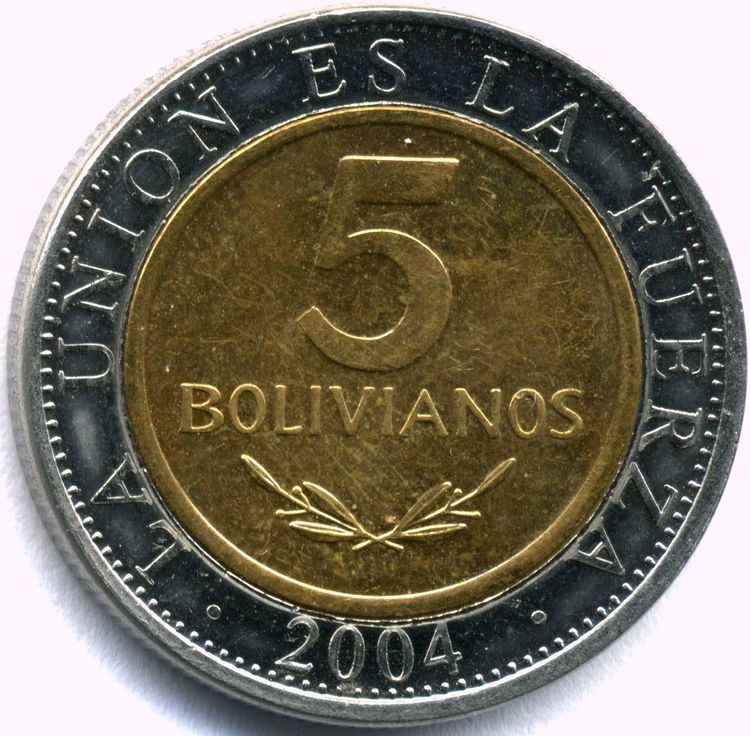Code BOB Exponent 2 Symbol Bs. or Bs | Number 068 ⁄100 centavo centavo Cvs. | |
 | ||
The boliviano (sign: Bs. or Bs; ISO 4217 code: BOB) is the currency of Bolivia. It is divided into 100 cents or centavos in Spanish. Boliviano was also the name of the currency of Bolivia between 1864 and 1963.
Contents
First boliviano
The first boliviano was introduced in 1864. It was equivalent to eight soles or half a scudo in the former currency. Initially, it was subdivided into 100 centécimos but this was altered to centavos in 1870. The name bolivar was used for an amount of ten bolivianos.
Second boliviano
Following many years of rampant inflation, the bolivian peso was replaced in 1987 by a new boliviano at a rate of one million to one ( when 1 US dollar was worth 1.8/1.9 million pesos ). At that time, 1 new boliviano was roughly equivalent to 1 U.S. dollar.
Coins
In 1988, stainless-steel 2, 5, 10, 20 and 50 centavo and 1 boliviano (dated 1987) coins were introduced, followed by stainless-steel 2 bolivianos in 1991. Copper-plated steel 10 centavos were introduced in 1997 and bi-metallic 5 bolivianos in 2001. The 2 and 5 centavo coins are no longer in circulation. The 2 boliviano coin has been minted in two sizes, both of which remain legal tender. The smaller 2 boliviano coin is almost the same as the 1 boliviano coin, leading to potential confusion, although the 2 boliviano coins are undecagonal whilst the 1 boliviano coins are round. All the coins in Bolivia has the obverse the number of the amount of money with the inscription "La union es la Fuerza" ("Union is strength" in Spanish) and in the reverse the coat of arms of Bolivia with the inscription "Estado Plurinacional de Bolivia" (Plurinational state of Bolivia).
Banknotes
In 1987, peso boliviano banknotes were overprinted with denominations in centavos and bolivianos to produce provisional issues of 1, 5, 10 and 50 centavos, and 1, 5 and 10 bolivianos. Regular issues followed the same year in denominations of 2, 5, 10, 20, 50, 100 and 200 bolivianos. The 2 boliviano note was replaced by a coin in 1991, with the same happening to the 5 boliviano in 2001, although the Bolivian central bank still lists the 5 boliviano note as "in circulation" -The 10 Bolivianos bill has in the obverse to the painter Cecilio Guzman and reverse an image of city of Cochabamba. -The 20 Boliviano bill has in the obverse to the lawyer Pantaleon Dalence and in the reverse an image of The Golden Colonial House of Tarija. The 50 Boliviano bill has in the obverse to the painter Melchor Perez and in the reverse you can see the Tower of Church of the Society of Jesus in the city of Potosi- The 100 Boliviano bill has in the obverse of the great historian Gabriel Rene Moreno and the reverse one image of the Mayor Real and Papal University of Saint Francisco Xavier of Chuquisaca in the capital, the city of Sucre, the 200 Boliviano bill has to the obverse to the writer and former president of Bolivia, Franz Tamayo and in the reverse an image of ruins of the Pre Inca empire of Tihuanaco in the shores of Lake Titicaca in the state or department of La Paz As of 2013. The 2 and 5 Bolivianos bills are officially out of circulation. [1].
Manufacture/Production
As of 2013 the Boliviano is still manufactured abroad, in countries such as United Kingdom, France, and Chile. Bolivia, although politically independent since 1825, is in this regard after two centuries not independent in many aspects, such as the monetary one, like many other ex-colonies throughout Latin America and the rest of the world.
Though Bolivia was one of the main mints of the colonial era (casa de la moneda, Potosí) the coining and printing of currency stopped due to lack of political interest and on the idea that foreign made coins and bank notes could be acquired at a lower price than the Bolivian made.
